

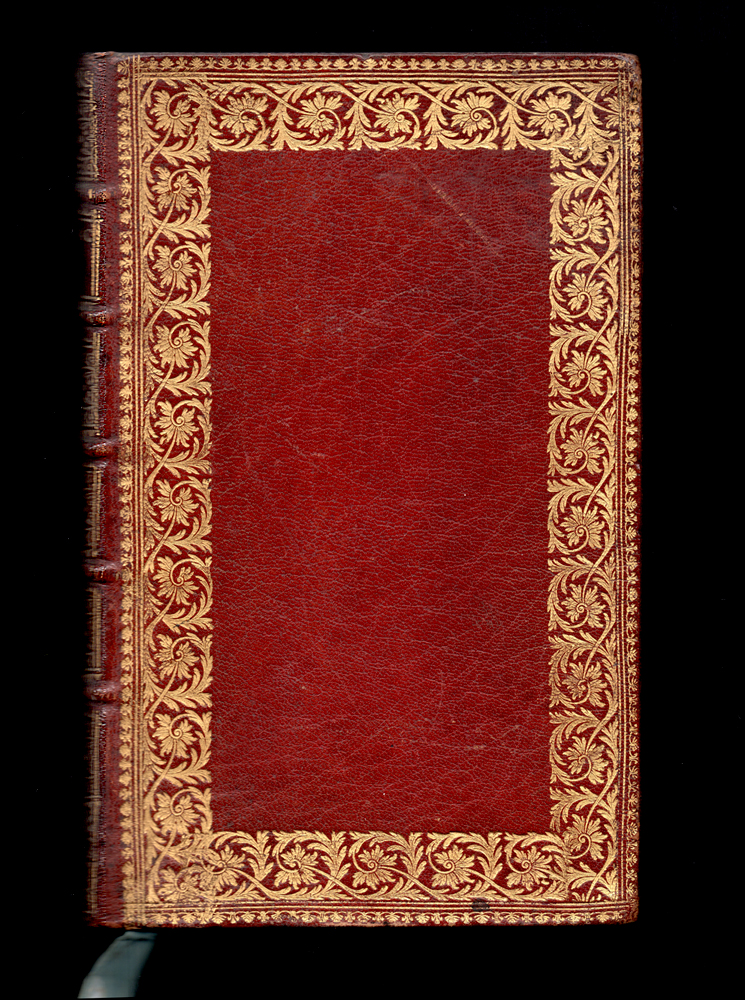
| On the previous page we showed comparisons between our eBay 1743 Almanach Royal and bindings found on certain Semaine Sainte examples that were similarly decorated with a SLB (scrolling leaf boarder) dentelle. I did not have the advantage of scanned images then as I do now. We can show very precisely that these dentelles all derive from the same SLB tool that we can assume was found and employed in the Dubuisson workshops. Now with these high resolution scans we can also give very price measurements of this tool. On this page I hope to pursue some other imprint comparisons that will further help to identify the Dubuisson's role in the execution of the decoration of SLB bindings. I maintain that this type of Dubuisson decoration is relatively rare using this specific SLB tool. To prove this point you only have to search the internet with google for Semaine Sainte publications especially those from the Jacques Collombat editions as well as all Almanach Royals. In hundreds of examples, I have found only 4, my 1743 Almanach Royal is so far, the only Almanach example known to me.Of the remaining Semaine Sainte examples, one is found on a 1723 printing, another on a 1727, and another on a 1741. The identical nature of these binding suggests that they were all made around the same time in the early 1740's. |
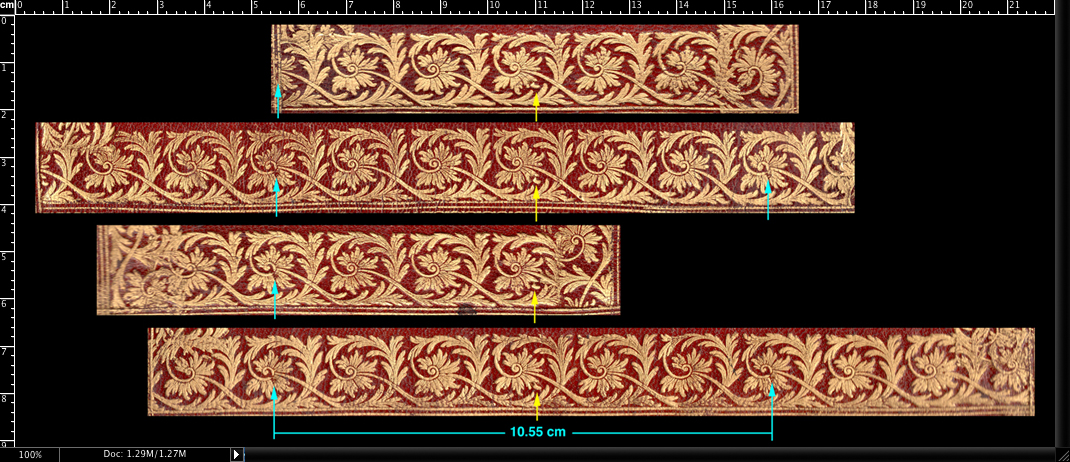
| In Comparative Diagram 1- we see 4 strips of SLB, the fact that there is no evident join in these strips suggests that this is in fact a wide roulette and not a plaque or block, that measures 10.55 cm in circumference. Click to enlarge this high resolution diagram to see better the identifiers which are seen to repeat every six units. |
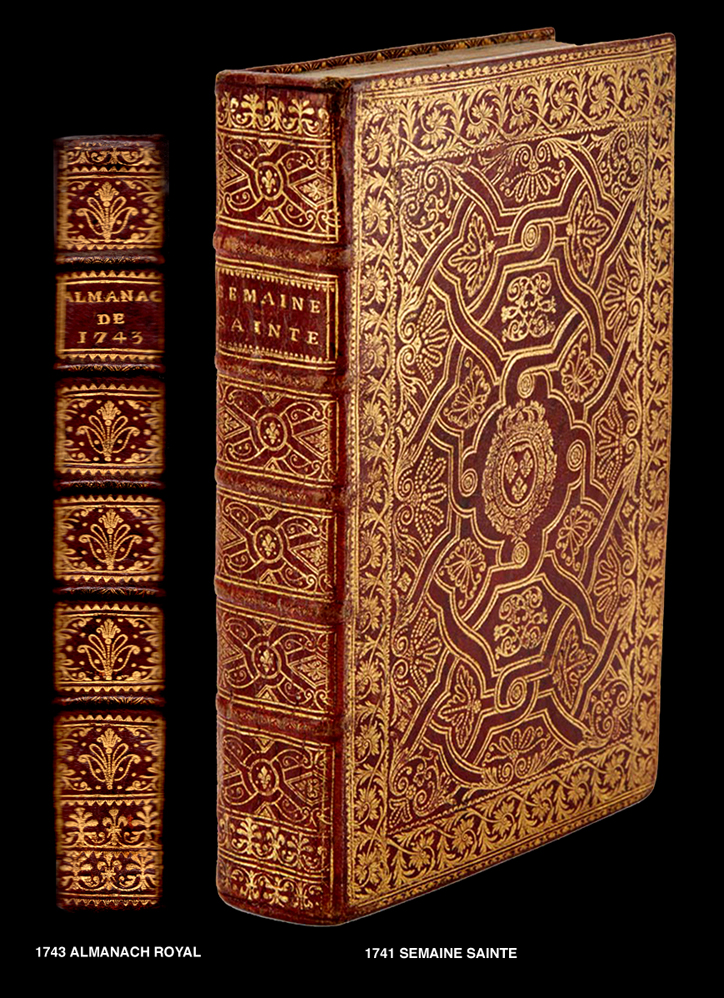
| In Comparative Diagram 2, we see the spine of our 1743 Almanach Royal compared with a 1741 Semaine Sainte (described below - see EXCEPTIONAL Reliure ...) the interest here is in showing that the pallets at the base of the spine are the same. To prove this we are first going to show in Comparative Diagram 3, high resolution images of the 1743 Almanach Royal example, and in Comparative Diagram 4 we show identifiers with which it will be easy to identify this pallet with certainty. |
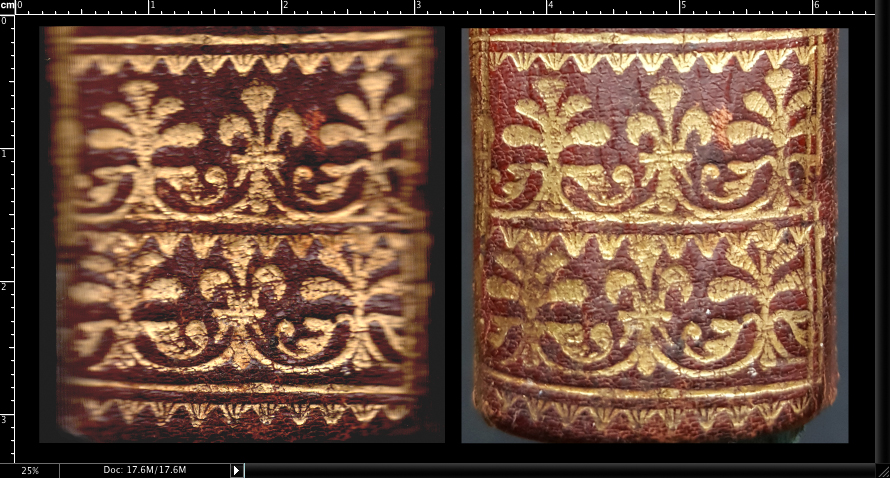
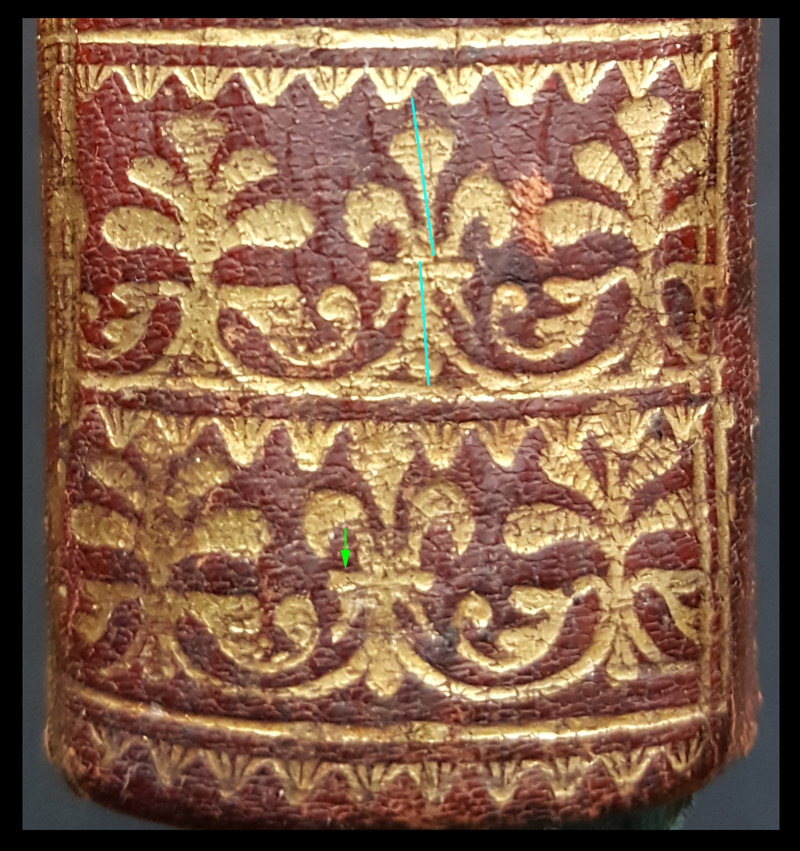
|
In Comparative Diagram 4 we see an enlarged photo showing eccentricities in the central fleur-de-lis that will enable easy identification of this very popular tool. The green arrow indicating that this shoulder of the fleur de lis, is wider than that of the other, the blue lines showing that the the head and tail of this imprint are not aligned as one would expect in a perfectly symmetrical fleur de lis. Barber 2013, shows 2 examples in his tool catalogue PAL 13 and Pal 14 that he describes as a "Palmette with hatched Lines and a double curl below, the lower one linking to the fleur-de-lis". W.Cat.114 is referenced however no photograph is provided for this binding, and the type model example shown (PAL 13) is somewhat different than our eBay example. Metivier shows 4 examples in her Figure 4 diagram (See Jeanne-Marie Métivier, « La reliure à la Bibliothèque du roi de 1672 à 1786 », in Mélanges autour de l'histoire des livres imprimés et périodiques, Paris, B.n.F., 1998 and describes her examples as roulettes fleur de lis et palmette which indeed they are, Barber on the other hand has cataloged them as pallets and roulettes (ROLLS) actually there might be examples of both. These appear to have been very popular tools and are found in a wide range of sizes that can be seen in use from the late 17th century to mid 18th and beyond. While most roulette examples appear very regular and symmetrical the larger examples such as those employed by Boyet closely resemble our 1743 Almanach Royal Semaine Sainte examples in their lack of symmetry and or regularity appearing somewhat poorly made. There are some strange coincidences found in comparing Boyets use of these tools, in as much as they are found on Boyet's Semaine Sainte bindings employed as pallets while the Dubuisson Semaine Sainte bindings employ these tools in the same place on the spines (see this page). Really the Boyet and the Dubuisson examples are very similar being only different in size (Dubuisson 11cm in height, Boyet 10 cm). I have previously catalogued the Boyet example in this size as C-5.(see this page) see Comparative Diagram 7. |
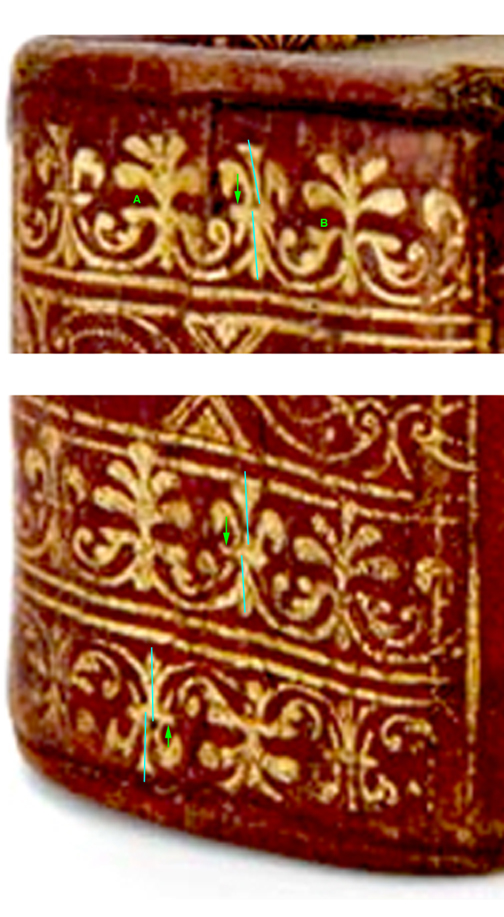
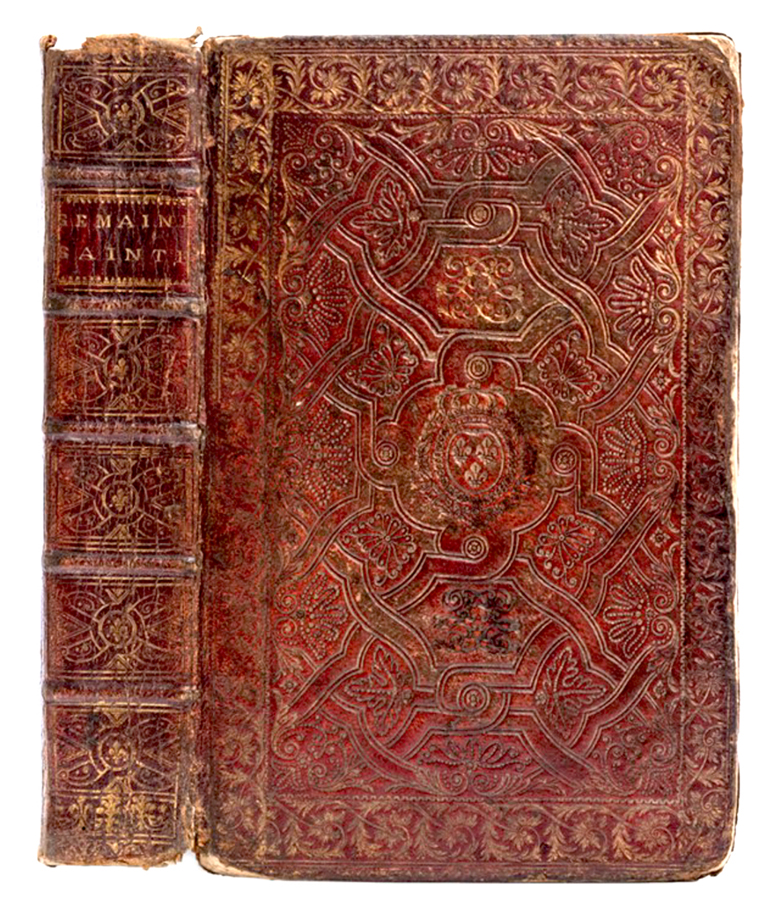
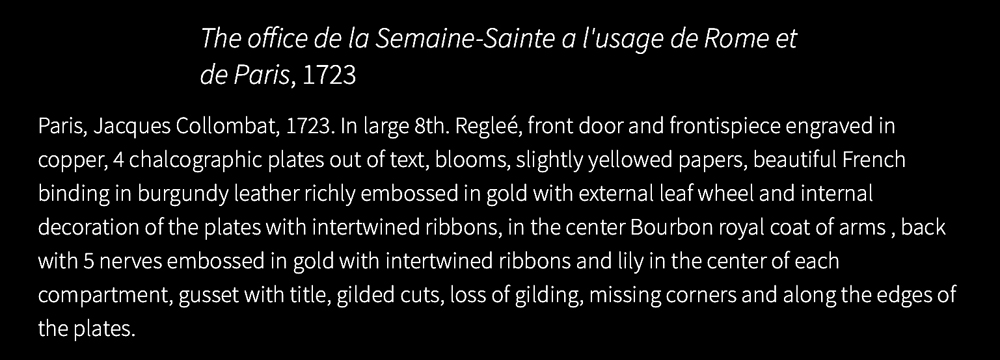
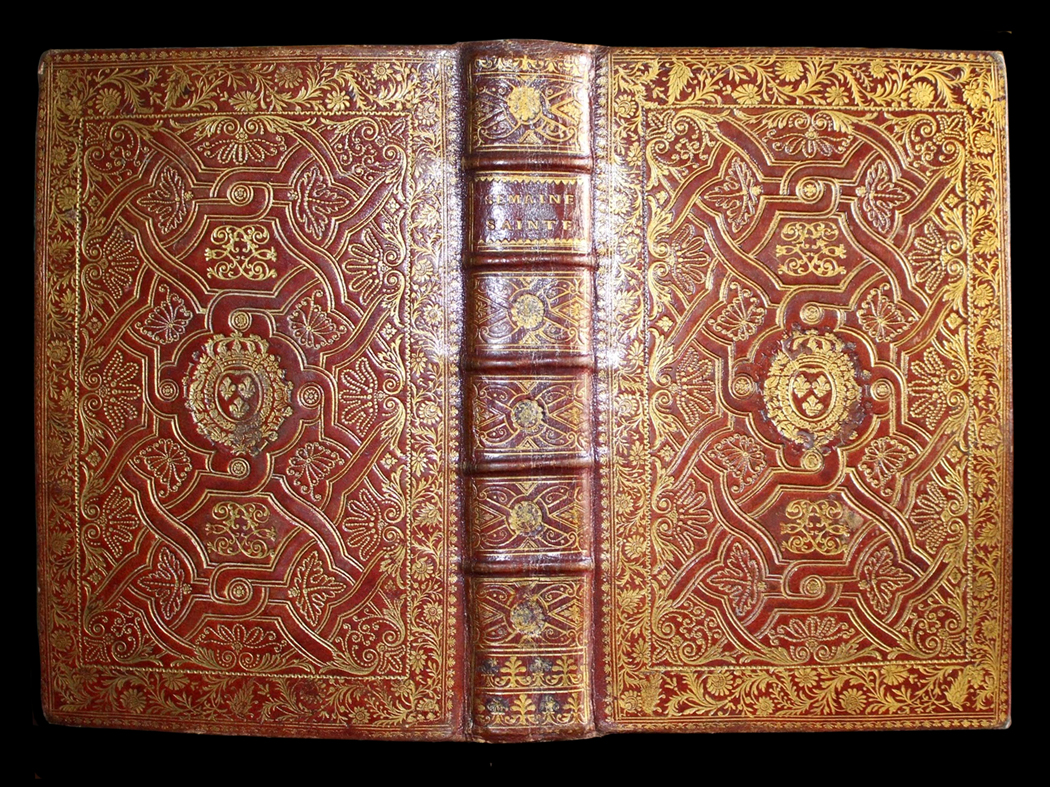
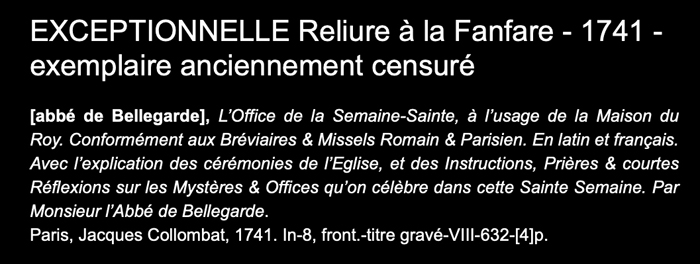
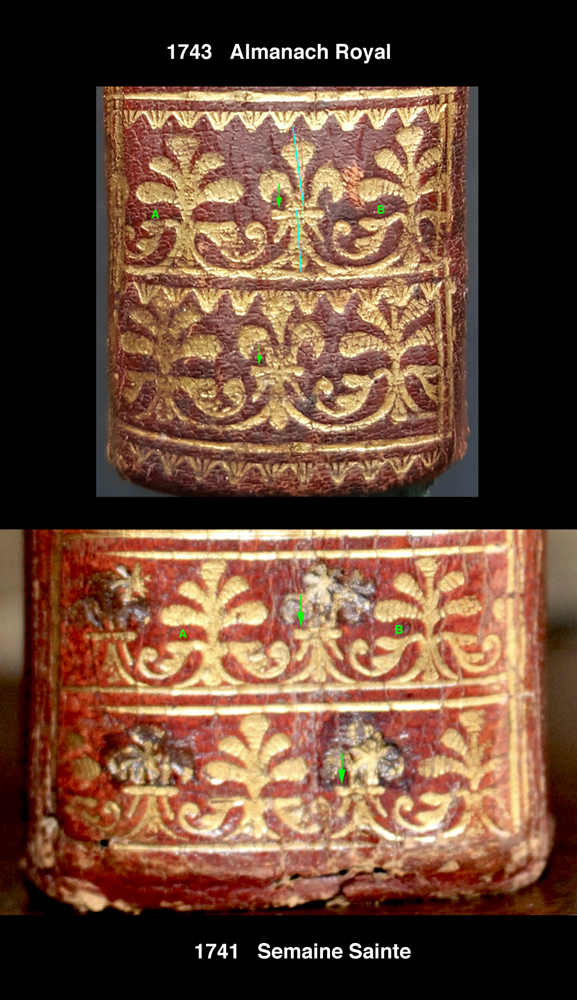
| In Comparative Diagram 6 we see the 1743 Almanach Royal pallet compared with the 1741 Semaine Sainte pallet. The arrow pointing out the shoulder difference, and the letters A and B indicating a difference in the palmette shoulders. Shoulder A being nearly flat while B is more curved. When you can find these three indicators together you are assured that these imprints derive from the same Dubuisson tool. |
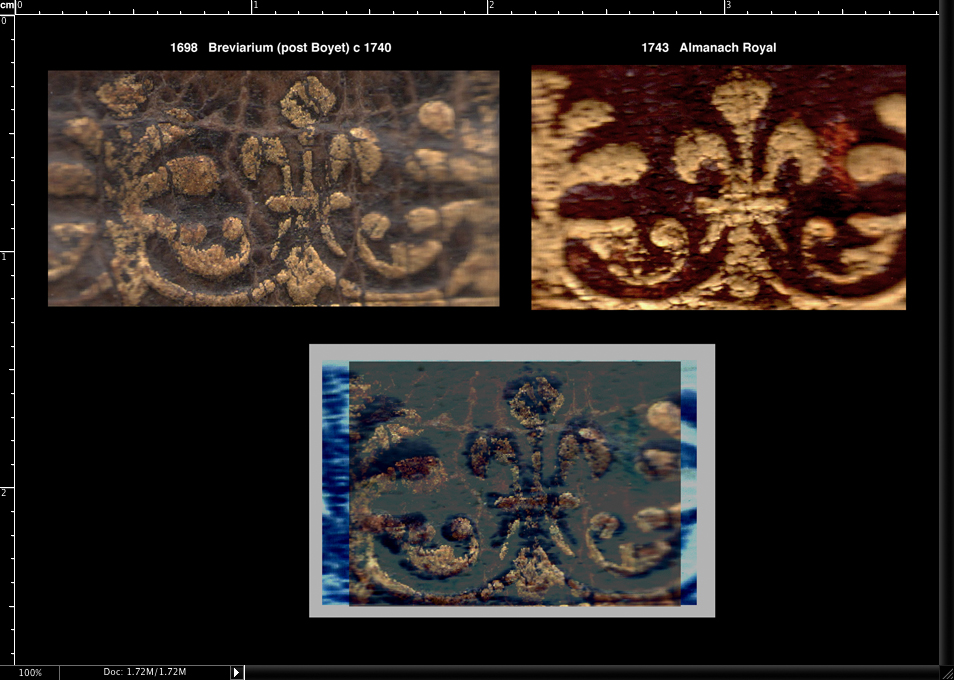
| In Comparative Diagram 7, I show a Boyet example that is probably post Boyet as well as our ebay 1743 Almanach Royal example, both of these are high resolution scans and very accurate in the vertical (center). On the overlay we can see that these imprints are not the same size, the Boyet example is smaller being around 10mm in height while the 1743 Dubuisson example is closer to 11mm. |
|
Now we need to mention one further point, the BnF in their information about Luc-Antoine Boyet Notice written by Fabienne Le Bars Last release date july 2016 Permalink : http://reliures.bnf.fr/ark:/12148/cdt9x1jn/ list his death as 1733. Here is what they have to say as well as a google translation ... Reçu maître en 1684, Luc-Antoine Boyet est titulaire de la charge de relieur du roi de 1698 à 1733 (lettres de nomination en date du 23 novembre 1698), succédant à Claude Le Mire. Il connut de son vivant une très grande réputation. En 1696, il est cité comme relieur de l'évêque de Nîmes, Esprit Fléchier (1632-1710) et, sur la foi de témoignages contemporains, il eut dans le premier tiers du XVIIIe siècle comme clients tous les grands noms de la bibliophilie naissante, parmi lesquels notamment Charles-Jérôme de Cisternay Du Fay (1662-1723), le comte d'Hoym (1694-1736) ou encore l'abbé Charles-Orléans de Rothelin (1691-1744). Son oeuvre reste néanmoins paradoxalement méconnue, en l'absence de documents ou détails sur la nature des commandes qui lui furent passées par ces personnages ; seul un minutieux examen des fers présents sur ces reliures permet, par mise en relation avec des réalisations attestées de Boyet, de les identifier au cas par cas. Les principaux documents d'archives concernant Boyet sont en fait des mémoires relatifs au travail exécuté pour le roi (1704-1707 ; 1711 ; 1722-1723 ; 1728-1729) et les comptes de l'Imprimerie royale, où il apparaît ponctuellement dès 1714 puis très régulièrement entre 1726 et 1732. On peut lui attribuer par exemple toute une série de reliures exécutées pour des exemplaires de présentation de l'Histoire des médailles de Louis XIV (Métivier 2002). Received master in 1684, Luc-Antoine Boyet held the position of bookbinder to the king from 1698 to 1733 (letters of appointment dated November 23, 1698), succeeding Claude Le Mire. He enjoyed a very high reputation during his lifetime. In 1696, he was cited as bookbinder for the Bishop of Nîmes, Esprit Fléchier (1632-1710) and, on the basis of contemporary testimonies, in the first third of the 18th century he had as clients all the great names of the nascent bibliophile. , including in particular Charles-Jérôme de Cisternay Du Fay (1662-1723), the Count of Hoym (1694-1736) and Abbé Charles-Orléans de Rothelin (1691-1744). His work remains nevertheless paradoxically unknown, in the absence of documents or details on the nature of the orders which were passed to him by these characters; only a meticulous examination of the irons present on these bindings makes it possible, by linking them with attested achievements of Boyet, to identify them on a case-by-case basis. The main archival documents concerning Boyet are in fact memoirs relating to the work carried out for the king (1704-1707; 1711; 1722-1723; 1728-1729) and the accounts of the Royal Printing Office, where he appears punctually from 1714 then very regularly between 1726 and 1732. We can attribute to him, for example, a whole series of bindings executed for presentation copies of the History of Louis XIV's medals (Métivier 2002). Even though the Bnf have stated all of this they have chosen to show only one binding as an example of his work. Boyet was beyond doubt one of the greatest French bookbinders who ever lived and yet they show nothing of his vast and varied production. Now what I wanted to mention here is that after 1733, many bindings continued to appear fashioned in the same manner and decorated with the same Boyet tools for at least another decade. As evidenced in Comparative Diagram 8 we see a 1746 Semaine Sainte example as well as a 1728. |
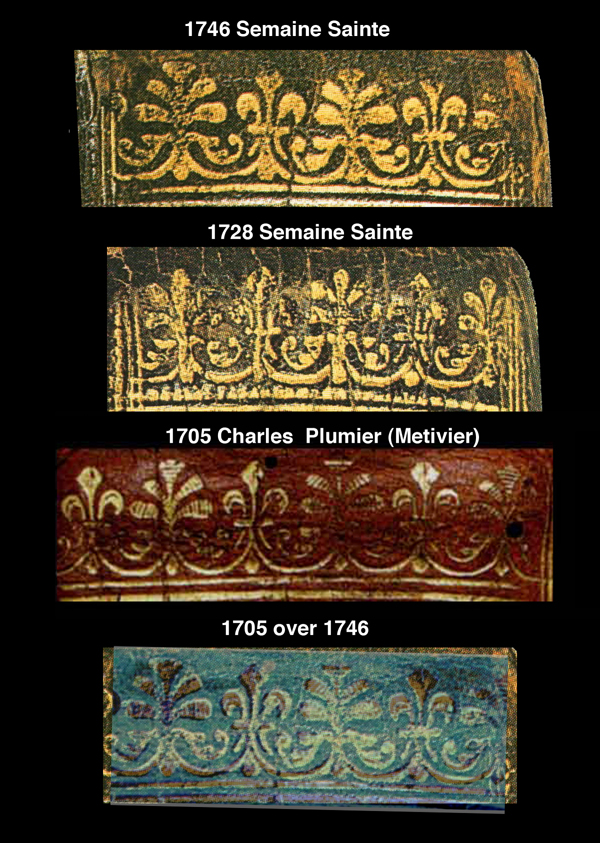
|
click here to return to the HOME page. click here to see the INDEX of the 2017 pages. see below links to previous work |
| Even experts are sometimes wrong, before you spend thousands on a book, please do your own research! Just because I say a certain binding can be attributed to le Maitre isn't any kind of guarantee, don't take my word for it, go a step further and get your own proof. In these pages I have provided you with a way of doing just that. |
| Virtual Bookings, created by L. A. Miller | return to the Home page of VIRTUAL BOOKBINDINGS |